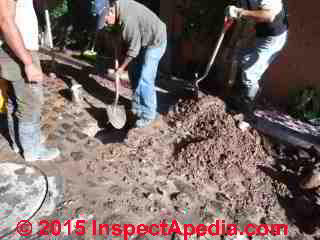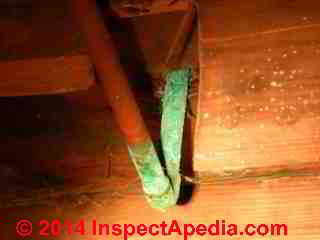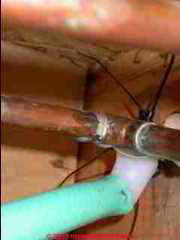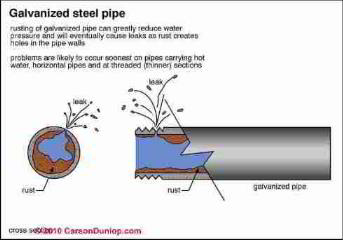 Corrosion & Leaks in Copper or Steel Water Pipes
Corrosion & Leaks in Copper or Steel Water Pipes
Causes of metal water piping corrosion or leaks
- POST a QUESTION or COMMENT about the cause & prevention of water pipe leaks.
What causes leaks in metal piping?
This article describes the many causes of leaks in metal water pipes. We list the factors that explain green corrosion on copper pipes, leaks at pinhole perforations, leaks at pipe joints, and other leak types on metal piping.
The article also discusses the important role of water chemistry and even electrical grounding mistakes in the development of pipe leaks or pipe corrosion.
Some of these leak causes may also explain leaks in metal drain piping.
Our page top photo shows a water line leak that's extra trouble to repair: a break in water piping between the building interior and the water main in the street. Some careful attention to the cause of the leak (once the line was excavated) helped avoid a repeat visit of the plumbers to this home.
InspectAPedia tolerates no conflicts of interest. We have no relationship with advertisers, products, or services discussed at this website.
- Daniel Friedman, Publisher/Editor/Author - See WHO ARE WE?
Causes of Leaks in Metal Water Piping or Water Cylinders / Water Heaters
 Reader Question: green stains, corrosion, gritty material around copper pipes & pipe fittings or connections
Reader Question: green stains, corrosion, gritty material around copper pipes & pipe fittings or connections
(Jan 14, 2015) JohnGotts said:
What is the green gritty mineral buildup around some sweat joints in my boiler installation?
Can it be removed or should it be left alone?
30 January 2015 Sal said:
If your house water main is green near the electric ground connection does that mean the ground wire is going bad or is bad
[Click to enlarge any image]
Reply: common causes of corrosion on or leaks in copper piping
Copper pipes have been in wide use since the 1850's and have been produced by a variety of methods and in a variety of thickness ranging from heavy gauge to extruded thin-wall copper.
In the U.K. light gauge piping came into wide use beginning in the 1920's. A thin oxide coating (CaCO3) that forms inside copper water piping helps resist corrosion by reducing further dissolution of the copper pipe from the interior as may other natural corrosion inhibitors - (Campbell (1994)).
John
Most likely it's an oxide of copper caused by corrosion. Look at it closely to be sure there are no leaks.
Watch out: never "pick" at or probe corrosion. A slow leak in metal piping may be just that, very slow, actually leaking through a pinhole where the piping material is quite thin.
When you scrape at or poke at such a corroded spot the risk is that you convert a small leak that would have given you time to hire a plumber into a big emergency leak that requires that you shut down the building water supply before making a call for emergency (more expensive) plumbing repairs.
Sal:
Watch out: Green corrosion on a water pipe that is found only around the electrical ground is worth some further checking: stray electrical currents or improper grounding could be causing the corrosion that you see.
Some green corrosion on copper piping is common and may not necessarily mean a leak is present. For example we may see corrosion where solder flux ran out around a solder joint during pipe connections by sweating (copper soldering).
Other causes of green corrosion on copper pipes, besides an actual leak (see our comment to John in just above) are listed below.
Our photo (left) shows an ingenious temporary "repair" by a homeowner who observed a small drip at a badly-soldered copper water pipe elbow. As the joint was hard to reach he made a tiny funnel and drain to catch the drip and direct the water to a nearby laundry sink.
While we respect all clever midnight or Sunday Afternoon emergency building repairs, this is not a long term nor reliable plumbing leak fix. It was clever, though.
- Chemistry of the water and water additives, conditioners, disinfectants, particularly chlorine - (Edwards et als (1994)) and sulfides (Jacobs & Edwards (2000))
Note that in addition to the corrosivity index of water, other factors such as reverse-osmosis treatment can make water much more aggressive, resulting in corrosion and leaks in metal piping.
If an RO system treated water is causing leaks the leaks would be expected in any water supply piping that is downstream from a central or building-RO treatment system.
See REVERSE OSMOSIS WATER TREATMENT
Plastic piping is more resistant to the effects of water chemistry, but there too, some water contents such as high levels of chlorine can lead to failures in some plastics.
See PLASTIC PIPE LEAK CAUSES - Condensation on copper piping exterior surfaces due to cold pipe temperatures on copper lines running through humid or wet areas. In our photo at below left you can see condensation on horizontal runs of cold water piping in a damp crawl area.
See CONDENSATION or SWEATING PIPES, TANKS
- Cold water pitting: described by the Foundation for Water Research and posed as occurring more in hot water heaters (water cylinders), cold water pitting is more likely in cold water pipes or at the bottom of water heater cylinders that remain below 40°C (104°F), usually at private well (borehole) water systems that have pH between 7-8.2. - Foundation for Water Research (2010)
- Defective or damaged plastic piping: plastic water supply or drain piping may fail and leak from a variety of causes, including improper installation or use of defective plastic piping materials
See PLASTIC PIPE LEAK CAUSES
and see these product defect piping leak topics:
JM Eagle® DEFECTIVE PVC PolyVinyl Chloride PIPING LAWSUIT
Kitek® PLASTIC PIPE LEAKS, CLASS ACTION SETTLEMENT
PlumbPex® PEX PIPE LEAKS, CLASS ACTION SETTLEMENT - De-zincification of brass fittings used on copper piping (also related to water chemistry)
See PEX BRASS CONNECTOR LEAKS - for a discussion of de-zincification - Electrical grounding errors or stray currents in the electrical ground system can cause corrosion and leaks in metal piping, water tanks, water heaters, ground water heat pump systems etc.
See WATER PIPING GROUND BOND - Leaks from mechanical damage, improperly made pipe connections (sloppy soldering)
- Leaks due to corrosion due to dissimilar metals. In More Reading for this article
see GALVANIC SCALE & METAL CORROSION
and
see DIAELECTRIC PIPE FITTINGS - Leaks due to corrosive water (cuprosolvency or improper water pH - look for blue water, pinholes in pipes, and hot water heater or hot water cylinder (in the U.K.) failures.
See CORROSIVITY or ACIDITY of WATER - - Leaks due to exterior water sources: Other leaks that are dripping onto the copper piping exterior surfaces
- Soldering flux corrosion: the runout of soldering paste left on copper pipes or on brass or copper pipe fittings can cause corrosion.
Interestingly Oliphant (2003) pointed out that lead itself, used in soldering materials particularly before 1986 (in the U.S.) can contribute to copper corrosion.
Image above provided courtesy of Carson Dunlop Associates, a Toronto home inspection, education & report writing tool company [ carsondunlop.com ].
See GALVANIZED STEEL WATER PIPING for a discussion of the additional factors involved in leaky galvanized steel pipes.
- Stagnation: if copper or other metal pipes are left un-used but full of water for long periods chemical changes in the system such as changes in the pH of the water may damage the protective layer on the pipe surfaces and may contribute to corrosion, particularly if the water supply is high in corrosivity.
- Water contaminants: aside from water chemistry that we mention in this discussion, biological contaminants in water may cause water pipe corrosion and leaks.
Particularly in soft water with a high level of carbon, the growth of biological contaminants and possibly a thin bio-film on the pipe interior surface may form.
Other water contaminants may include debris that forms a deposit on the pipe surface, often on the interior of the pipe along its bottom or at elbows.
Debris deposits in turn may permit spot or point corrosion of the copper (or other metal piping material). - LeChevallier (1993)
See WATER TREATMENT EQUIPMENT CHOICES - Water flow rate: higher speed of water flowing through pipes can increase the rate of pipe corrosion
- Water temperature: depending as well on water chemistry, hot water may be more corrosive to some piping systems
At LEAK TYPES, WATER SUPPLY or DRAIN PIPES - we describe the types of leaks that occur in water supply and drain piping with an eye (or an ear) towards leak detection and towards hidden leaks in buildings
AtReferences or Citations for this article we include research citations on the various causes of corrosion on or leaks in building piping systems.
...
Continue reading at PLASTIC PIPE LEAK CAUSES or select a topic from the closely-related articles below, or see the complete ARTICLE INDEX.
Or see these
Recommended Articles
- CORROSIVITY or ACIDITY of WATER - how water chemistry corrodes pipes or water heaters / water cylinders
- LEAK TYPES, WATER SUPPLY or DRAIN PIPES - where do leaks occur and how to find them
- PEX BRASS CONNECTOR LEAKS
- PLASTIC PIPE LEAK CAUSES
- PLUMBING LEAK DETECTION METHODS
- PLUMBING LEAK DETECTION & SHUTOFF DEVICES
- RADIANT SLAB TUBING LEAKS
- SINK LEAK DIAGNOSIS & REPAIR
- WELL PIPING LEAK DIAGNOSIS
Suggested citation for this web page
LEAK CAUSES in WATER PIPING at InspectApedia.com - online encyclopedia of building & environmental inspection, testing, diagnosis, repair, & problem prevention advice.
Or see this
INDEX to RELATED ARTICLES: ARTICLE INDEX to PLUMBING SYSTEMS
Or use the SEARCH BOX found below to Ask a Question or Search InspectApedia
Ask a Question or Search InspectApedia
Try the search box just below, or if you prefer, post a question or comment in the Comments box below and we will respond promptly.
Search the InspectApedia website
Note: appearance of your Comment below may be delayed: if your comment contains an image, photograph, web link, or text that looks to the software as if it might be a web link, your posting will appear after it has been approved by a moderator. Apologies for the delay.
Only one image can be added per comment but you can post as many comments, and therefore images, as you like.
You will not receive a notification when a response to your question has been posted.
Please bookmark this page to make it easy for you to check back for our response.
IF above you see "Comment Form is loading comments..." then COMMENT BOX - countable.ca / bawkbox.com IS NOT WORKING.
In any case you are welcome to send an email directly to us at InspectApedia.com at editor@inspectApedia.com
We'll reply to you directly. Please help us help you by noting, in your email, the URL of the InspectApedia page where you wanted to comment.
Citations & References
In addition to any citations in the article above, a full list is available on request.
- Baylis, John R. "PREVENTION OF CORROSION AND" RED WATER"." Journal (American Water Works Association) 15, no. 6 (1926): 598-633.
- Beale, David J., Michael S. Dunn, Paul D. Morrison, Nichola A. Porter, and David R. Marlow. "Characterisation of bulk water samples from copper pipes undergoing microbially influenced corrosion by diagnostic metabolomic profiling." Corrosion Science 55 (2012): 272-279.
- Campbell, Hector S. "A natural inhibitor of pitting corrosion of copper in tap‐waters." Journal of Applied Chemistry 4, no. 12 (1954): 633-647.
- "Cause of Copper Corrosion in Plumbing Systems, A Review of Current Knowlege", Foundation for Water Research, Allen House, the Listons, Liston Road, Marlow, Bucks SL7 1FD U.K., TEL: +44 (0) 1628 891589, Website: www.fwr.org, retrieved 30 Jan 2015, original source: http://www.fwr.org/copper.pdf
- Boulay, Nicolle, and Marc Edwards. "Role of temperature, chlorine, and organic matter in copper corrosion by-product release in soft water." Water research 35, no. 3 (2001): 683-690.
- Campbell, H. S. "Pitting corrosion in copper water pipes caused by films of carbonaceous material", Journal of Applied Chemistry, Vol. 77 1950
- Edwards, Marc, and Abhijeet Dudi. "Role of chlorine and chloramine in corrosion of lead-bearing plumbing materials." Journal (American Water Works Association) (2004): 69-81.
- Dietrich, A. M., D. Glindemann, F. Pizarro, V. Gidi, M. Olivares, M. Araya, A. Camper et al. "Health and aesthetic impacts of copper corrosion on drinking water." Water Science & Technology 49, no. 2 (2004): 55-62.
- Edwards, M., Schock, M. R. and Meyer, T. E., "Alkalinity, pH and copper corrosion by-product releases", Journal of the American Water Works Association, March 1996
- Fuji T., Kodama T. and Haruo B. "The effect of water quality on pitting corrosion of copper tube in hot soft water", Corrosion Science, Vol 24, No. 10 pp 901-912. 1984
- Jacobs, S., and M. Edwards. "Sulfide scale catalysis of copper corrosion." Water Research 34, no. 10 (2000): 2798-2808.
- Karalekas Jr, Peter C., Christopher R. Ryan, and Floyd B. Taylor. "Control of lead, copper, and iron pipe corrosion in Boston." Journal (American Water Works Association) (1983): 92-95.
- LeChevallier, Mark W., Cheryl D. Lowry, Ramon G. Lee, and Donald L. Gibbon. "Examining the relationship between iron corrosion and the disinfection of biofilm bacteria." Journal (American Water Works Association) (1993): 111-123.
- Lytle, Darren A., and Mallikarjuna N. Nadagouda. "A comprehensive investigation of copper pitting corrosion in a drinking water distribution system." Corrosion Science 52, no. 6 (2010): 1927-1938.
- Mattsson, Einar. "Corrosion of copper and brass: practical experience in relation to basic data." British Corrosion Journal 15, no. 1 (1980): 6-13.
- MCNEIILL, LAURIE S., and Marc Edwards. "Iron pipe corrosion in distribution systems." Journal (American Water Works Association) (2001): 88-100.
- Oliphant, R. J. Causes of copper corrosion in plumbing systems. Foundation for Water Research, 2003.
- Oliphant, R. J., "Contamination of potable water by lead from leaded copper alloys", . 2nd International conference on Water Pipeline Systems 1994. BHR Group Conference Series Publication No. 10. Mechanical Engineering Publications Limited (MEP), London. ISBN 0 85298 921 0
- Reyes, A., M. V. Letelier, R. De la Iglesia, B. González, and G. Lagos. "Microbiologically induced corrosion of copper pipes in low-pH water." International Biodeterioration & Biodegradation 61, no. 2 (2008): 135-141.
- Rushing, Jason C., and Marc Edwards. "The role of temperature gradients in residential copper pipe corrosion." Corrosion science 46, no. 8 (2004): 1883-1894.
- Schock, Michael R. "Causes of temporal variability of lead in domestic plumbing systems." Environmental monitoring and assessment 15, no. 1 (1990): 59-82.
- Sosa, M., S. Patel, and M. Edwards. "Concentration cells and pitting corrosion of copper." Corrosion 55, no. 11 (1999): 1069-1076.
- Wagner, D., W. Fischer, and H. H. Paradies. "Copper deterioration in a water distribution system of a county hospital in Germany caused by microbially influenced corrosion–II. Simulation of the corrosion process in two test rigs installed in this hospital." Materials and Corrosion 43, no. 10 (1992): 496-502.
- Our recommended books about building & mechanical systems design, inspection, problem diagnosis, and repair, and about indoor environment and IAQ testing, diagnosis, and cleanup are at the InspectAPedia Bookstore. Also see our Book Reviews - InspectAPedia.
- In addition to citations & references found in this article, see the research citations given at the end of the related articles found at our suggested
CONTINUE READING or RECOMMENDED ARTICLES.
- Carson, Dunlop & Associates Ltd., 120 Carlton Street Suite 407, Toronto ON M5A 4K2. Tel: (416) 964-9415 1-800-268-7070 Email: info@carsondunlop.com. Alan Carson is a past president of ASHI, the American Society of Home Inspectors.
Thanks to Alan Carson and Bob Dunlop, for permission for InspectAPedia to use text excerpts from The HOME REFERENCE BOOK - the Encyclopedia of Homes and to use illustrations from The ILLUSTRATED HOME .
Carson Dunlop Associates provides extensive home inspection education and report writing material. In gratitude we provide links to tsome Carson Dunlop Associates products and services.




